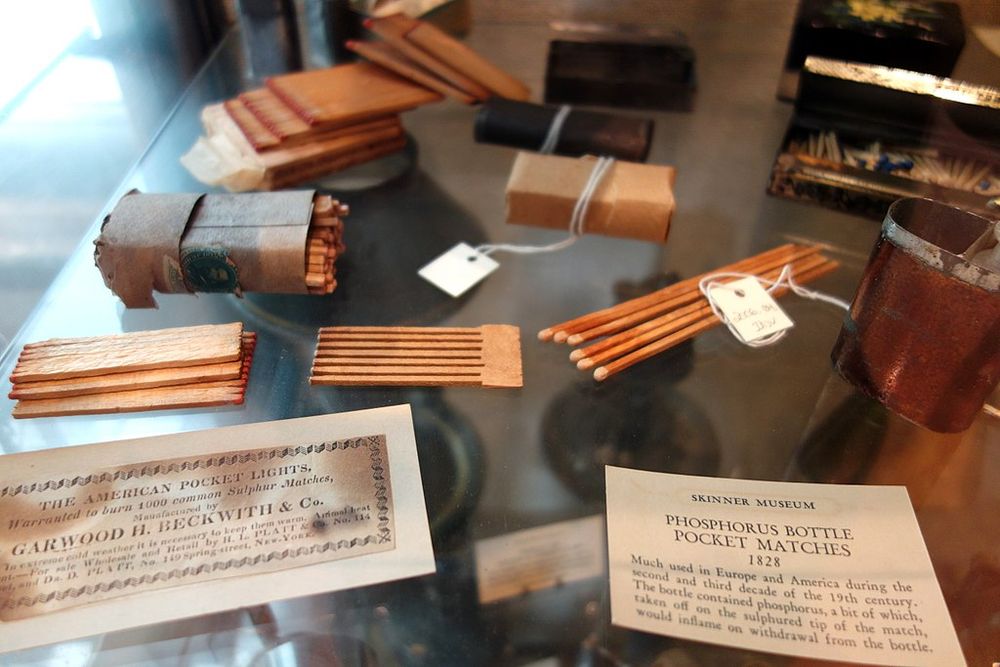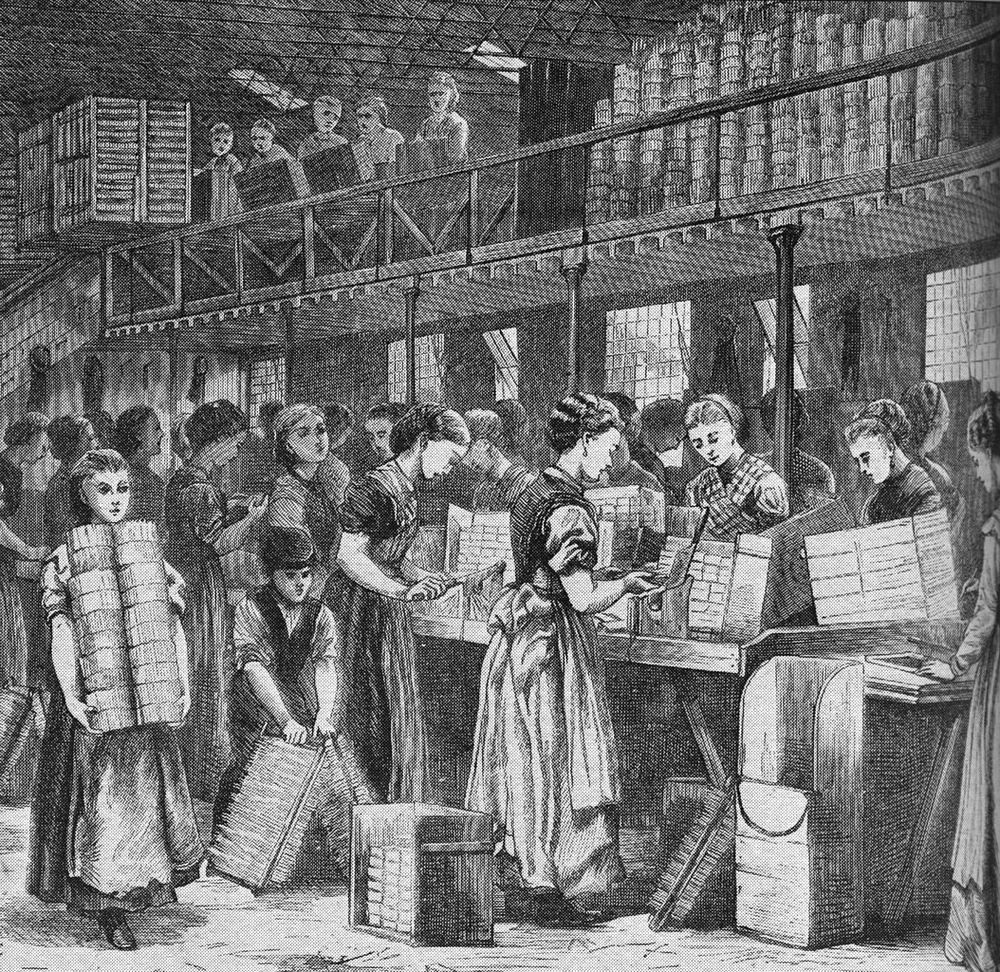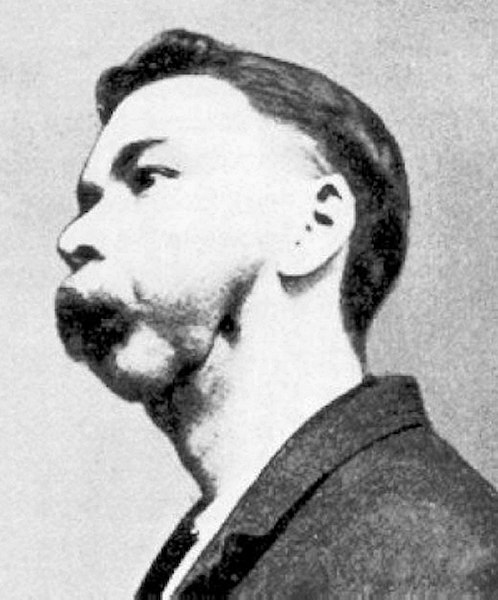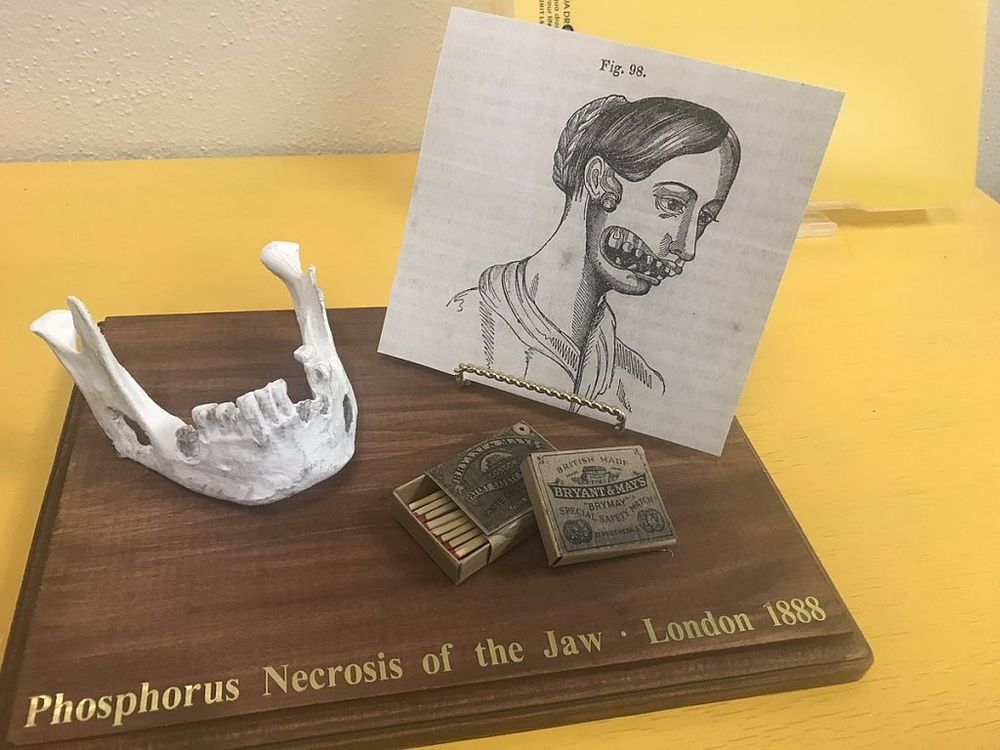Before the invention of matches, making fire was a tedious business, so people often shared fires from already existing flames. Whenever a new fire had to be lit, a variety of different techniques were used, all of which involved rubbing one material with another to create sparks by friction. Flint and steel was a common combination.
Later on, chemicals were used to induce fire and the first self-igniting match was born. Invented by Jean Chancel in 1805, it consisted of a match head made of a mixture of potassium chlorate, sulfur, gum arabic and sugar. When the match tip was dipped into a vial of sulfuric acid, the match ignited. However, this kind of match was expensive and was also relatively dangerous, so Chancel's matches never really became widely adopted or in commonplace use.

Phosphorus bottle pocket matches, circa 1828. Joseph Allen Skinner Museum. Photo: Daderot/Wikimedia Commons
In 1828, Samuel Jones of London invented the Promethean match, named after Prometheus who, according to Greek legend, stole fire from the gods. His match consisted of a glass bead containing sulfuric acid, the outside of which was wrapped with paper impregnated with an igniting compound. When the glass was broken by means of a small pair of pliers, or even with the user’s teeth, the paper in which it was wrapped was set on fire. Many users of the match used to crush the vial with their teeth. “I carried with me some promethean matches, which I ignited by biting,” wrote Charles Darwin in The Voyage of the Beagle. “It was thought so wonderful that a man should strike fire with his teeth, that it was usual to collect the whole family to see it.”
These first matches were extremely difficult to ignite, and they frequently erupted in a shower of sparks. In addition, the smell was particularly offensive.
In 1826, John Walker, an English chemist and druggist, created the first successful friction match. It consisted of wooden splints or sticks of cardboard coated with sulfur and tipped with a mixture of sulfide of antimony, chlorate of potash, and gum. When scraped against a rough surface, the matchhead ignited. The sulphur in the paste helped the splints to catch fire, and the odor of the burn was subdued by the addition of camphor. Walker began selling them in boxes of 50 priced at one shilling. With each box was supplied a piece of sandpaper, folded double, through which the match had to be drawn to ignite it.
In 1830, Frenchman Charles Sauria substituted white phosphorus for the antimony sulfide, creating new phosphorus matches that produced a more volatile flame and had to be kept in airtight metal boxes. They became very popular, especially in the United States, where they went by the name of loco foco and gave rise to a new political party of the same name. Encouraged by ease of use and increased demand, the new matches became highly sought commodities, and manufacturing changed from small entrepreneurial shops to large factories in London, Glasgow, Amsterdam, Paris, Vienna, and Berlin.

Women working in a match factory in London in 1871.
To produce these matches, workers called “dippers” stood in front of shallow trays filled with water, steam-heated from below, in which was dissolved sticks of white phosphorus mixed with a few other chemicals. Racks of sticks twice the length of a matchstick were then dipped either side and allowed to dry before the sticks were chopped in half. The resulting matches were then boxed up ready to be sold.
Working 14 hours a day in poorly-ventilated factories these dippers breathed in copious amounts of phosphorus fumes. Others who mixed the chemicals as well as those who boxed up the matches were also exposed to high levels of phosphorus. Soon thousands of workers began to show symptoms of phosphorous toxicity. It began with tooth ache, swelling of the gums, and then the teeth fell out. The face swelled up and abscesses along the jaw oozed foul-smelling pus. Holes opened up in the face along the jaw line, through which could be seen the dead bone underneath. Sometimes the bone glowed in the dark from the accumulated phosphorus. The only remedy was to remove the jawbone. This condition was known as phossy jaw, and it left many match factory workers permanently disfigured.

A phossy jaw sufferer.

A lithograph from the 1870s showing a skull with jaw affected by phosphorus poisoning. Photo: Wellcome Library, London.
Beyond the oral effects of this condition, these workers also experienced respiratory symptoms such as coughing, drainage and bloody discharge from the lungs. In chronic cases, the toxic phosphorus reached the brain provoking seizures.
The earliest report of phosphorus necrosis was made in 1845, but it took another half a century before the matchmakers of the Bryant & May factory of London went on strike. Many of the protesters were women. They lived in abject poverty, in filthy housing unfit for human habitation and were often subject to prolonged hours of backbreaking work making matches. In addition to the low pay, excessive fines were issued for simple infraction such as keeping an untidy workbench, talking, having dirty feet, and being late. Dropping trays of matches attracted steeper fines.

Photo: mybestdentists.com
In 1888, well-known social activist Annie Besant published a scathing article in her halfpenny weekly paper The Link. This angered the Bryant & May management who tried to get their workforce to sign a paper contradicting it, which they refused to do. The management dismissed a worker on some other pretext, which set off the strike, with approximately 1,400 women and girls refusing to work by the end of the first day. The management quickly offered to reinstate the sacked employee but the women then demanded other concessions, particularly in relation to the unfair fines which were deducted from their wages. Within two weeks, the whole factory had stopped work.
Meanwhile, two French chemists, Henri Savene and Emile David Cahen, discovered that phosphorus could be replaced with phosphorous sesquisulfide resulting in similar “strike-anywhere” matches, with the benefit that the new compound was not toxic. The first company to produce phosphorus sesquisulfide matches commercially was the British company Albright and Wilson in 1899. However, white phosphorus continued to be used until the early 20th century. Finland was one of the first to prohibit the use of white phosphorus in 1872, followed by Denmark in 1874, France in 1897, Switzerland in 1898, and the Netherlands in 1901. The United Kingdom passed a law in 1908 prohibiting its use in matches after 31 December 1910. The United States did not pass a law, but instead placed a “punitive tax” in 1913 on white phosphorus–based matches, one so high as to render their manufacture financially impractical, and Canada banned them in 1914. India and Japan banned them in 1919. China followed, banning them in 1925.
The discontinuation of white phosphorous and introduction of modern manufacturing processes had almost eliminated phossy jaw, when by a twist of fate, contemporary medicine resurrected this disease. A group of drugs known as Bisphosphonates, commonly used in treating osteoporosis and cancer has the potential to cause deterioration of the jaw. The condition, bisphosphonate-associated osteonecrosis of the jaw (BON), is similar to phossy jaw and is sometimes known as “bis-phossy jaw”.



Comments
Post a Comment